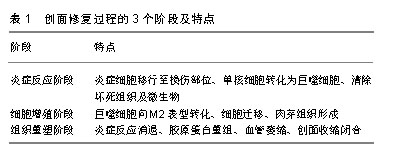| [1]Aboulhoda BE, Abd El Fattah S. Bone marrow-derived versus adipose-derived stem cells in wound healing: value and route of administration. Cell Tissue Res. 2018;374(2):285-302.[2]Zonari A, Martins TM, Paula AC, et al. Polyhydroxybutyrate-co- hydroxyvalerate structures loaded with adipose stem cells promote skin healing with reduced scarring. Acta Biomater. 2015;17:170-181.[3]Goodarzi P, Alavi-Moghadam S, Sarvari M, et al. Adipose Tissue-Derived Stromal Cells for Wound Healing. Adv Exp Med Biol. 2018;1119:133-149.[4]Dong Y, Hassan WU, Kennedy R, et al. Performance of an in situ formed bioactive hydrogel dressing from a PEG-based hyperbranched multifunctional copolymer. Acta Biomater. 2014;10(5):2076-2085.[5]Annamalai RT, Turner PA, Carson WF 4th, et al. Harnessing macrophage-mediated degradation of gelatin microspheres for spatiotemporal control of BMP2 release. Biomaterials. 2018;161: 216-227.[6]Kim BS, Tilstam PV, Springenberg-Jung K, et al. Characterization of adipose tissue macrophages and adipose-derived stem cells in critical wounds. PeerJ. 2017;5:e2824.[7]Massee M, Chinn K, Lei J, et al. Dehydrated human amnion/chorion membrane regulates stem cell activity in vitro. J Biomed Mater Res B Appl Biomater. 2016;104(7):1495-1503.[8]Foubert P, Zafra D, Liu M, et al. Autologous adipose-derived regenerative cell therapy modulates development of hypertrophic scarring in a red Duroc porcine model. Stem Cell Res Ther. 2017;8(1):261.[9]Prasai A, El Ayadi A, Mifflin RC, et al. Characterization of Adipose- Derived Stem Cells Following Burn Injury. Stem Cell Rev. 2017;13(6): 781-792.[10]Kokai LE, Marra K, Rubin JP. Adipose stem cells: biology and clinical applications for tissue repair and regeneration. Transl Res. 2014;163(4): 399-408.[11]Deng J, Shi Y, Gao Z, et al. Inhibition of Pathological Phenotype of Hypertrophic Scar Fibroblasts Via Coculture with Adipose-Derived Stem Cells. Tissue Eng Part A. 2018;24(5-6):382-393.[12]Lee EY, Xia Y, Kim WS, et al. Hypoxia-enhanced wound-healing function of adipose-derived stem cells: increase in stem cell proliferation and up-regulation of VEGF and bFGF. Wound Repair Regen. 2009;17(4): 540-547.[13]Nie C, Yang D, Xu J, et al. Locally administered adipose-derived stem cells accelerate wound healing through differentiation and vasculogenesis. Cell Transplant. 2011;20(2):205-216.[14]Chiang RS, Borovikova AA, King K, et al. Current concepts related to hypertrophic scarring in burn injuries. Wound Repair Regen. 2016;24(3): 466-477.[15]Stuermer EK, Lipenksy A, Thamm O, et al. The role of SDF-1 in homing of human adipose-derived stem cells. Wound Repair Regen. 2015;23(1): 82-89.[16]丁世超,张培华.自体脂肪干细胞移植在创面愈合的研究进展[J].海南医学, 2017, 28(7): 1127-1129.[17]Prichard HL, Reichert W, Klitzman B. IFATS collection: Adipose-derived stromal cells improve the foreign body response. Stem Cells. 2008; 26(10):2691-2695.[18]Kuo YR, Wang CT, Cheng JT, et al. Adipose-Derived Stem Cells Accelerate Diabetic Wound Healing Through the Induction of Autocrine and Paracrine Effects. Cell Transplant. 2016;25(1):71-81.[19]陈筑昕,周双白,李青峰.脂肪干细胞来源外泌体促进组织修复的应用进展[J].组织工程与重建外科杂志, 2018, 14(4): 219-222.[20]Li X, Xie X, Lian W, et al. Exosomes from adipose-derived stem cells overexpressing Nrf2 accelerate cutaneous wound healing by promoting vascularization in a diabetic foot ulcer rat model. Exp Mol Med. 2018; 50(4):29.[21]Annamalai RT, Turner PA, Carson WF 4th, et al. Harnessing macrophage-mediated degradation of gelatin microspheres for spatiotemporal control of BMP2 release. Biomaterials. 2018;161: 216-227.[22]Gelberman RH, Linderman SW, Jayaram R, et al. Combined Administration of ASCs and BMP-12 Promotes an M2 Macrophage Phenotype and Enhances Tendon Healing. Clin Orthop Relat Res. 2017; 475(9):2318-2331.[23]Manning CN, Martel C, Sakiyama-Elbert SE, et al. Adipose-derived mesenchymal stromal cells modulate tendon fibroblast responses to macrophage-induced inflammation in vitro. Stem Cell Res Ther. 2015;6:74.[24]殷东京,赵贤忠.脂肪干细胞联合湿润烧伤膏治疗难愈性创面的展望[J].中国烧伤创疡杂志,2017,29(1): 41-43.[25]杜俊凯,陈明月,徐之超,等.定向激活HIF-1协同脂肪干细胞对糖尿病小鼠皮肤创伤修复的促进作用[J].中华细胞与干细胞杂志(电子版),2018,8(2): 95-102.[26]Xu Q, A S, Gao Y, et al. A hybrid injectable hydrogel from hyperbranched PEG macromer as a stem cell delivery and retention platform for diabetic wound healing. Acta Biomater. 2018;75:63-74.[27]Sun L, Huang Y, Bian Z, et al. Sundew-Inspired Adhesive Hydrogels Combined with Adipose-Derived Stem Cells for Wound Healing. ACS Appl Mater Interfaces. 2016;8(3):2423-2434.[28]Su N, Gao PL, Wang K, et al. Fibrous scaffolds potentiate the paracrine function of mesenchymal stem cells: A new dimension in cell-material interaction. Biomaterials. 2017;141:74-85.[29]庄兢,杨宇,丁力,等.脂肪来源干细胞联合胶原蛋白生物工程支架移植干预大鼠慢性难愈合性创面血管内皮生长因子的表达[J].中国组织工程研究,2018, 22(33):5274-5280.[30]Niederkorn JY, Peeler JS, Mellon J. Phagocytosis of particulate antigens by corneal epithelial cells stimulates interleukin-1 secretion and migration of Langerhans cells into the central cornea. Reg Immunol. 1989;2(2): 83-90.[31]Dong Y, Rodrigues M, Kwon SH, et al. Acceleration of Diabetic Wound Regeneration using an In Situ-Formed Stem-Cell-Based Skin Substitute. Adv Healthc Mater. 2018;7(17):e1800432.[32]朱琳,李薇薇,刘志凯.人血管基质片段联合脂肪干细胞促进裸鼠放射性皮肤损伤的愈合[J]. 山东大学学报(医学版), 2017, 55(9): 66-72.[33]王超,王佐林. CGF与脂肪干细胞联合应用修复大鼠全层皮肤缺损的研究[J].口腔颌面外科杂志,2016,26(4):238-243.[34]张琳,富泽龙,冯锐.人脂肪干细胞复合富血小板血浆治疗裸鼠放射性皮肤损伤的实验研究[J].医学研究杂志,2015, 44(7): 57-61.[35]廖怀伟,韩超,刘丽忠,等.富血小板血浆凝胶对脂肪干细胞修复皮肤软组织缺损创面的影响[J].重庆医学, 2013, 42(32): 3859-3862.[36]李江锋,丁世超,亚伟,等. 维生素C促进高糖环境下人脂肪干细胞的增殖及相关机制[J].中国组织工程研究, 2017, 21(13): 1992-1997.[37]Xia X, Chiu PWY, Lam PK, et al. Secretome from hypoxia-conditioned adipose-derived mesenchymal stem cells promotes the healing of gastric mucosal injury in a rodent model. Biochim Biophys Acta Mol Basis Dis. 2018;1864(1):178-188. [38]刘培,胡振生,马玲,等. 脂肪间充质干细胞条件培养基制备温敏凝胶外用治疗皮肤烫伤[J].中国组织工程研究, 2017, 21(30): 4852-4859.[39]Foubert P, Liu M, Anderson S, et al. Preclinical assessment of safety and efficacy of intravenous delivery of autologous adipose-derived regenerative cells (ADRCs) in the treatment of severe thermal burns using a porcine model. Burns. 2018;44(6):1531-1542.[40]Foubert P, Barillas S, Gonzalez AD, et al. Uncultured adipose-derived regenerative cells (ADRCs) seeded in collagen scaffold improves dermal regeneration, enhancing early vascularization and structural organization following thermal burns. Burns. 2015;41(7):1504-1516.[41]Sung HM, Suh IS, Lee HB, et al. Case Reports of Adipose-derived Stem Cell Therapy for Nasal Skin Necrosis after Filler Injection. Arch Plast Surg. 2012;39(1):51-54.[42]董瑶,董飞君,李幼华.脂肪干细胞调节创面炎症反应并促进创面愈合[J].医学研究杂志, 2012, 41(3): 100-103. |
.jpg)

.jpg)
.jpg)